Are you a Quiet Speculation member?
If not, now is a perfect time to join up! Our powerful tools, breaking-news analysis, and exclusive Discord channel will make sure you stay up to date and ahead of the curve.
Last week I tried something different with my weekly column. I dug up a relevant article from the past—one that probably goes back before most readers were visiting this site—and provided some new perspective. Oftentimes the articles I write are evergreen, and with just some minor touch-ups can be just as useful today as they were years ago.
Because I received positive feedback on this new approach, I wanted to resurrect another piece I wrote. This one is even older: it goes all the way back to May of 2012. That's over six and a half years old! The article is about Alpha rares, and how they are an asset on their own due to their collectibility and rarity as opposed to player demand. The near mint versions are especially rare, and should be compared to artwork more so than gaming pieces.
The strategies mentioned in this article have paid off fantastically and I think they're just as valid today. I'll update some prices where relevant in the column below; new text will be in bold italics.
A couple weeks ago, the iconic painting “The Scream” by Edvard Munch sold at auction for a whopping $119,922,500. This placed Munch over Picasso in history as the artist with the most expensive piece of artwork ever sold. My reaction can best be encompassed by the central figure in the painting itself:
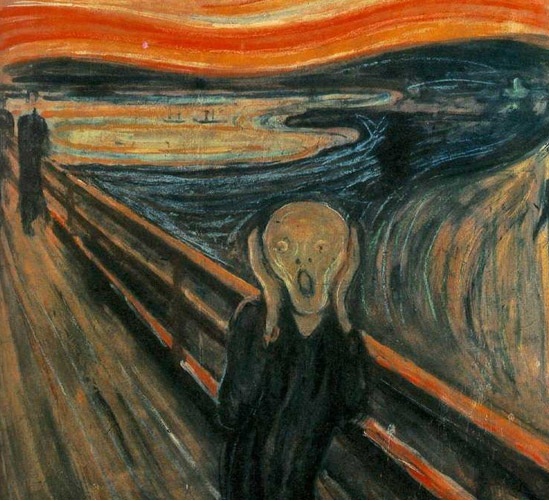
That is an incredibly large sum of money for a piece of artwork. No matter how much of a classic this painting is, it’s highly unlikely Munch could have ever imagined his work would fetch such a large sum a hundred years later.
What’s This Got To Do With Magic?
The iconic Alpha Black Lotus has appreciated significantly since its initial printing (albeit not to $119 Million). When I first began playing Magic, this card fetched around $300. As a newcomer to the game with no income on days other than my birthday and Christmas, this price seemed way too steep for a piece of cardboard.
Now, nearly twenty years later, circulated copies of this iconic Magic: the Gathering card have sold at auction for amounts in excess of $3,000—an increase of 1,000%! The only completed eBay listing for an Alpha Black Lotus is a rough one that sold back in November for around $15,000. From 1997 to today, that's an increase of 4,900%. The returns keep getting better and better!
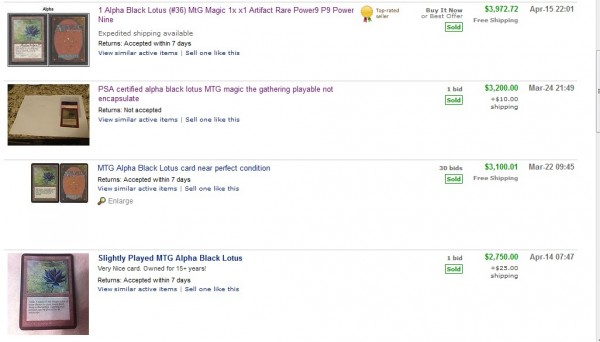
But these versions are circulated—they have seen play and they likely continue to see play in Vintage decks. There are far rarer versions of the Alpha Black Lotus—ones which are virtually unplayed in condition.
In fact the PSA-10 Mint Alpha Black Lotus has sold for upwards of $20,000 in previous sales. The [supposed] only one in existence is now for sale on eBay with an asking price of $100,000. Crazy? Yes! Crazier than paying $119 Million for a painting? Perhaps not. Card Kingdom has a near mint price of $40,000 for an Alpha Lotus, and that's not likely to be PSA 10. So I think a PSA 10 Alpha Lotus has got to be worth $100,000 or even more at this point.
NM Alpha vs. SP Alpha
Based on the most widely accepted numbers, each Alpha rare was printed about 1100 times by Wizards of the Coast. This count places any rare from Alpha high up on the list of rarest Magic: the Gathering cards.
But given these cards are nearly twenty years old, and most were played to oblivion, the subset of NM rare Alpha cards is even more elite. While it is impossible to garner exact numbers, even a generous fraction such as 10% NM would imply there are only about 100 copies of any NM Alpha rare card in existence.
Retailers have caught on to this fact—back in April, Star City Games significantly increased their buy and sell prices on NM Alpha/Beta cards only. They purposefully emphasize in their buylist that one should inquire about buylist prices for SP and MP copies. When we observe SCG is selling NM versions of Alpha rares at 2x the price of SP versions, we can certainly see why they’ve created this discrepancy.
But we don’t even have to lay out $20,000 to own a unique piece. Many NM Alpha rares are relatively much more affordable, yet they are still very rare and demand a healthy premium. NM copies of the five Laces from Alpha, for example, sell for $100 on Star City Games and they are even sold out of some! Consider Lifelace, which is about as playable as Song of Blood, yet far rarer and more expensive. Star City Games is (not surprisingly) sold out of Alpha Lifelace, but their near mint price is now $249.99. It's incredible that such an unplayable card can still more than double in price over six years' time.
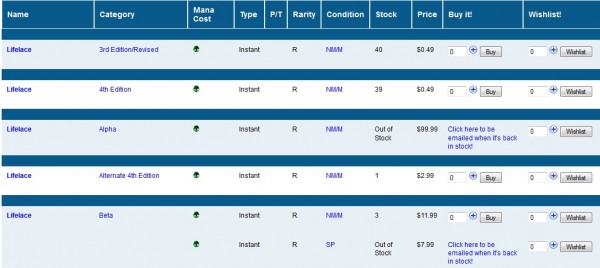
Even though the card is not useful in tournament or casual settings, the simple rarity of the NM Alpha Lifelace has driven its price up to surprising proportions. The card sells at 200x its 4th Edition price (now 500x), and it even far out-shadows the Beta version, which sells for only about one eighth the Alpha price. This is one difference between today and six years ago: Beta rares have caught up to their Alpha counterparts. Now a Beta Lifelace retails for only about one-third an Alpha copy. After all, near mint Beta rares are extremely rare as well.
An even more bizarre example lies in that pesky creature Fungusaur. That’s right, I said Fungusaur. Check out Star City Games’s sell price on that unplayable Alpha rare in NM form:
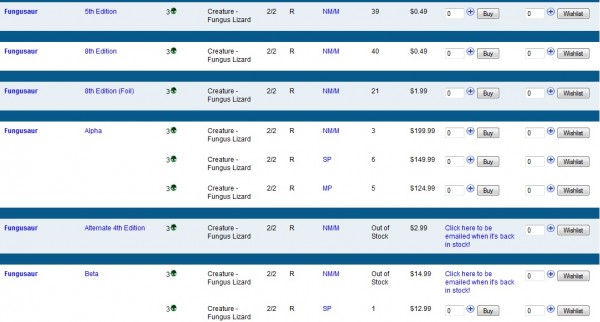
Anyone who has been playing this game long enough has opened one of these rares, and I’d even go out on a limb to say that virtually none of us were ecstatic to open this “crap rare.” Yet grab a NM Alpha copy of this beloved Fungus Lizard and you’ve got yourself a card that retails for $200! I’d wager a graded version with PSA score 8 or above may be even more expensive! These now retail for $349.99...I wonder if the same person is still collecting these or if they've return to circulation?
How could the Alpha version of this card be so expensive when it is so unplayable? My theory may surprise you…
Cornering the Market
Apparently there is a collector out there who owns at least 85 copies of Alpha Fungusaur. This picture is worth 1,000 words and well over $1,000:
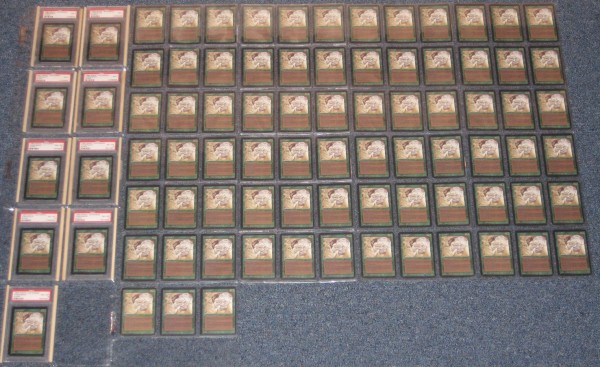
Own 85 copies of almost any card in the game of Magic—even something like foil Jace, the Mind Sculptor—and you still haven’t even scratched the surface of the total quantity in circulation. Own 85 copies of any Alpha rare, however, and you can officially manipulate the market.
These 85 Alpha Fungusaurs represent nearly 10% of the total quantity ever printed. This single collector likely owns more Alpha copies than the largest 10 MTG retailers combined. The largest retailer in the world, Star City Games, boasts 14 copies for sale at the moment—about one sixth of what is pictured above.
When print runs are so few, price manipulation is a possibility. One could even “corner the market” in a particular Alpha rare. In other words, acquiring only 85 copies of an Alpha rare, no matter the card, is sufficient to manipulate the card’s price. As a result, a major retailer like Star City Games sells this unplayable card at twice the price as its unplayable counterparts in Alpha. And again, NM copies take the cake, selling at $50 higher than SP versions. Fungusaur isn't the only Alpha card being collected. A while ago, a number of people were attempting to collect 5% of a given Alpha card's print run. I'm not sure how many of these collections are still intact, but I'd wager it's nonzero. This is probably still a thing.
What Should We Do With This Information?
I strongly discourage you from attempting to corner the market in any of these rare cards. To do so is very risky, and profiting from the endeavor is not easy. Attempt to sell a significant quantity of stock and you’ll likely kill the price, rendering the remainder of your collection worth far less.
Still, there is something to be learned here. NM Alpha rares are incredibly difficult to acquire. Some retailers, like ABU Games, have known this for a while now. Others, like Star City Games, are finally catching on and altering their prices to reflect this. Still other retailers such as Troll and Toad, as well as smaller eBay sellers, have not fully embraced this information. By now every retailer that cares about older cards has caught on that Alpha rares in near mint condition are extremely scarce.
As a result I've managed to snag not one, but two NM Alpha Two-Headed Giant of Foriys from a well-known retailer at the reasonable price of $55.99. This seems like a steep price to pay for another unplayable card, but a quick visit to Star City Games’s buylist and you’ll see that they are buying NM copies of this oldie for $60. Hence, I made an immediate $8 profit between the two copies I purchased. I wish I had kept this card! I flipped it for arbitrage, but now buylist is $420. I could have made far more than $8!
These opportunities are out there. One other recent acquisition I made was a sweet PSA-8 graded Alpha Earthquake for $59.00. Although not pristine enough to command a major premium, Star City Games will still buy the card at $60 and sell at $100. This one is even more painful! Earthquake is played in Old School and now buylists for $550. I had a few Alpha cards like this. And while I wish I had exercised more patience, keeping them for the long term, I must acknowledge the fact that gains from my near mint Alpha investments helped me in acquiring my Unlimited Black Lotus. It's all about prioritization I suppose.
But the overall goal isn’t to make $1 here and there selling cards to retailers’ buylists. Instead, I want you to consider the long haul. An unplayable NM Alpha rare may never reach the same prices as a Black Lotus, but collectors looking to complete their sets will need one Fungusaur for every Black Lotus. With Magic growing in popularity, combined with the fact that Alpha cards are perpetually aging, we have a recipe for significant gains.
Cards that once fetched pennies are now selling for $100. Could the growth rate continue? Will there be a point in time when NM Alpha Fungusaurs are so difficult to find that they will break four-digit prices? Graded ones may… This is the crux of my article: I believe this approach is just as valid today as it was back in 2012. Alpha rares are only getting harder to find as collectors absorb more and more copies. Barring a total collapse of Magic, these remain solid investments for the long-term.
These rarities don’t follow the normal ebb and flow of pricing like normal Magic cards do. Instead of moving trajectories comparable to the stock market, they instead follow paths resembled by classic artwork. Incredibly sparse, NM Alpha rares (especially graded highly) can grow in price at astronomical rates as long as there is a market for them.
Perhaps five years down the line I will have my NM Alpha Two-Headed Giants graded in hopes of a boost in value (facepalm...wish I kept it 5 years!). They may never be worth as much as a NM Black Lotus, but one thing is for certain—if Star City Games feels they are worth acquiring at $60 each, I am certainly going to acquire them below that price any chance I can get.
You may want to consider the same.
-Sigmund Ausfresser
@sigfig8
I had no Sigbits segment six-and-a-half years ago. So let's take a look at some surprising Alpha numbers from this week in 2018.
- Funny enough, the Alpha rare with the lowest buylist on Trader Tools is none other than Lifelace: $125. Considering these were buylisting for $60 6.5 years ago, it's still impressive to see the price more than double since. I don't think it's a remotely bold prediction to say these will buylist for over $250 in 2015. The trajectory is practically a given unless paper Magic dies.
- Thanks to the rise of Old School, popular cards from the format have really skyrocketed the most since 2012. Consider Chaos Orb, for example, which now buylists for $4200. According to Trader Tools, the best buylist back in mid-2012 was $171. Now THAT'S a good return on investment!
- The Alpha card with the best spread on Trader Tools is Demonic Hordes. It currently has a buylist price of $720 but TCG Mid is listed at $300. Obviously you can't find a nice copy for $300 anymore—this is likely the last copy that sold on TCGplayer. I believe this is a reflection of the rate of price change on these cards. The price jumped so quickly that copies were never even listed between $300 and $720. If they were, they would have sold and TCG's pricing would have reflected as much. These cards really went through an exponential growth period, though now prices have settled a bit. This is likely a temporary respite, however, and I expect prices to soar yet again at some point.
Bonus aside: Here's another Alpha article written by Chas Andres from 2012, with some amusing prices cited. I wish I had bought so much more Alpha back then.


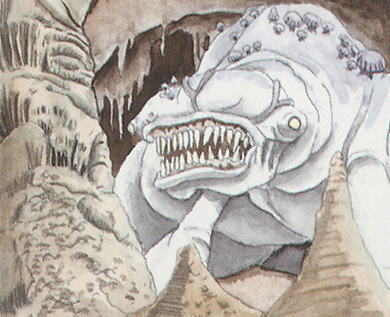



This article has aged so well…Your NM 2-headed giants would now have been sold for $2000. I think that every single NM alpha rare has cracked 4 digits by now.
To own one is to own a piece of history. One of the 1008 pieces of history of a single card you can have.
No joke! I only wish I had kept those cards longer. I was tempted by the easy, quick profit and lost out on the big time gains, sadly.